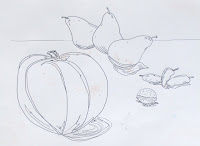I have noticed in the past year a proliferation of, well, not
all that many really, but several anyway, new businesses in the metro area that
offer painting lessons while serving glasses, if not carafes, of wine. What?! As John McEnroe famously
says, “You cannot be serious!”
Before you think I am one of those who frown on such
behavior, drinking that is, not painting, let me assure you I am not. Relaxing
with a glass of wine at the end of a long day of painting is, well, relaxing.
And people, including painters, are free, of course, to do
whatever they want as long as it’s legal, at least in this part of the world.
In my opinion, the two just don’t go together, and I question
the seriousness of either the painters and/or the drinkers in the crowd. Other
than making a buck, I don’t know why a business person would consider mixing the
two.
I’m guessing the patrons (notice I’m not calling them
artists) see it as a social event—a way to meet people and have fun. There’s
nothing wrong with that, but let’s call it what it is--a cocktail hour event
with an unusual twist.
Rather than just bar-hopping tonight, let’s add a little
culture to our lives with some fine arts, and, oh by the way, let’s paint us a
picture.
However, unbeknownst to many, or so it seems, is the fact
that painting takes hard work and concentration.
I cannot imagine anyone doing his or her best work with a
paintbrush in one hand and a glass of wine in the other. Even if you’ve already
done the preliminary planning and have your paper or canvas all ready to go,
you still have to be able to put the paint where you want it to go, that is, if
you’re serious.
And that brings me back to my original point—this cannot be serious.
Painting takes a clear head and a steady hand. Drinking wine does not.
Keep On Painting



